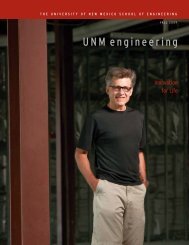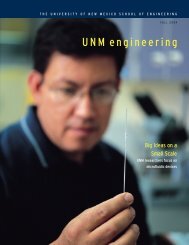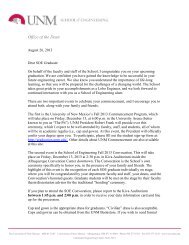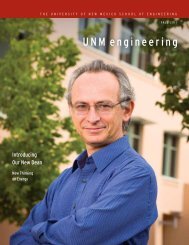UNM engineering - School of Engineering - University of New Mexico
UNM engineering - School of Engineering - University of New Mexico
UNM engineering - School of Engineering - University of New Mexico
Create successful ePaper yourself
Turn your PDF publications into a flip-book with our unique Google optimized e-Paper software.
Luan collaborated with researchersat <strong>University</strong> <strong>of</strong> Maryland, <strong>University</strong><strong>of</strong> Notre Dame, and <strong>UNM</strong> Radiologyto develop new four-dimensionaltreatment techniques that optimize theleaves and synchronize the angle <strong>of</strong> thebeam with the body’s movement. Theteam used computational geometryand powerful algorithms to createthe program.Gamma knife treatment uses focused beams <strong>of</strong> radiation to treat brain tumors. The Automatic PatientPositioning System (APS) on the Elekta Leksell Gamma Knife ® 4C System makes dynamic Gamma Kniferadiosurgery possible. Photos courtesy <strong>of</strong> Elekta, Atlanta, GA, www.elekta.com.001001110111011101010111011010010“You need committed collaborators in medicine and a background in the theory <strong>of</strong>computer science to solve these problems. We have both here at <strong>UNM</strong>.” Shuang Luan010101110110100101010101110010001In a second LINAC project, Luanand researchers at the <strong>University</strong><strong>of</strong> Maryland and <strong>University</strong> <strong>of</strong> NotreDame pioneered another treatmentoptimization technique. Normally,LINAC machines use up to 13 individualbeams <strong>of</strong> radiation positioned atdifferent angles to treat a tumor.Using computational geometry, theteam developed Single ARC DosePainting Therapy, treatment plannings<strong>of</strong>tware that moves the beams aroundthe patient, continuously deliveringradiation from all possible directions.Luan says results are excellent.“Treatment time can be as much as80% shorter and we can deliver ahigher dose <strong>of</strong> radiation to the tumorand less to the surrounding structures.”The team has filed a provisional patentfor the technique.Gamma knife treatment uses focusedbeams <strong>of</strong> radiation to treat braintumors. Again, using powerfulalgorithms, Luan and his researchpartner at <strong>University</strong> <strong>of</strong> California atSan Francisco developed s<strong>of</strong>tware thatoptimizes the beams, turning theminto a relative brush that “paints” thecontours and volume <strong>of</strong> the tumorwith radiation. The dynamic processcovers the tumor faster and moreevenly. Ultimately, the s<strong>of</strong>tware could beincorporated into a treatment planningprogram. A provisional patent has alsobeen filed for the technique.Improving cancer treatment is a longway from the theoretical work Luan hadplanned to pursue. His goals changedthe day he saw how his work could heal.“I’ll never forget the first day they usedmy algorithm to treat patients,” saysLuan. “I was nervous, but it worked.That’s when I decided to make it thefocus <strong>of</strong> my career.”Probing RNAiLike Luan, Terran Lane is using hiscomputer science expertise to conductbioinformatic research. One focus <strong>of</strong>Lane’s work is ribonucleic acid (RNA),which is closely associated with DNA.While DNA contains the code for cellgrowth, RNA acts as the “middleman,” controlling the flow <strong>of</strong> geneticinformation between DNA and theproteins it ultimately produces. Manyresearchers believe understandingRNA will dramatically improve diseasetreatment and genomic research.Recently, biology researchersdiscovered a cellular process, nowcalled RNA interference (RNAi), thatcan be used to stop malfunctioninggenes from producing bad proteins.Lane is conducting RNAi researchwith immunologists in the <strong>UNM</strong>Biology Department and the Centerfor Evolutionary and TheoreticalImmunology. He uses algorithms tocreate models <strong>of</strong> chemical probesthat connect with RNA and stop theprocess <strong>of</strong> protein production. “We’redesigning these RNAi probes totarget specific RNA and disrupt them,while creating as few side effects aspossible,” explains Lane. The challengeis how to design the short interferingRNA probe (siRNA) so that the probetargets a specific malfunctioning geneor protein without disrupting beneficialones. The powerful algorithms help theresearchers evaluate all the possiblevariations in the structure <strong>of</strong> the probe.It’s early in the research, but Lane andhis team have made one important find.“Some <strong>of</strong> the early work in the areaassumed that everything was highlyspecific and you didn’t have to worryabout side effects,” explains Lane.“But we predicted computationallythat you’re likely to have side effectsunless you work to design probes thatare free <strong>of</strong> side effects.” The teamalready developed one algorithm thatother RNAi researchers can use todesign more effective drugs with fewerside effects. It’s clear that with theirbioinformatic research already yieldingresults, Lane and Luan are turningcomputer codes into hope. d<strong>UNM</strong> <strong>Engineering</strong> 15









